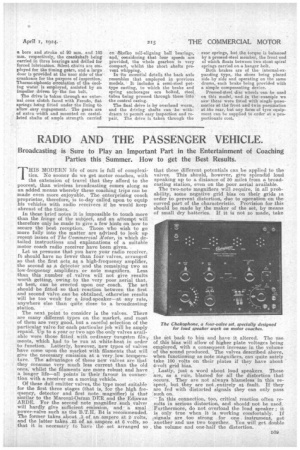RADIO AND THE PASSENGER VEHICLE.
Page 33

If you've noticed an error in this article please click here to report it so we can fix it.
Broadcasting is Sure to Play an Important Part in the Entertainment of Coaching Parties this Summer. How to get the Best Results.
THIS MODERN life of ours is full of complexities. No sooner do we get motor coaches, with the extension of travel that they afford to the poorest, than wireless broadcasting comes along as an added means whereby these coaching trips can be made even more enjoyable. The enterprising coach proprietor, therefore is to-day called upon to equip his vehicles with radio receivers if he would keep abreast of the times.
In these brief notes it is impossible to touch more than the fringe of the subject, and an attempt will therefore only be made to give a few hints on how to secure the best reception. Those who wish to go more fully into the matter are advised to look up recent issues of The Commercial Motor, in which detailed instructions and explanations of a suitable motor coach radio receiver have been given. .
Let us presume that you have your radio receiver. It, should have no fewer than four valves, arranged so that the first acts. as a high-frequency amplifier, the second as a detector and the remaining two as low-frequency amplifiers or note magnifiers. Less than this number of valves will not give results worth getting, owing to the very poor aerial that, at best, can be erected upon our coach. The set should be fitted so that reaction between the first and second valve can be obtained, otherwise results will be too weak for a loud-speaker--at any rate, anywhere else than quite close to a broadcasting station.
The next point to consider is the valves. Thera are many different types on the market, and most of thein are very good, but a careful selection of the particular valve for each particular job -will be amply repaid. Up to a year or two ago the only valves available were those fitted with ordinary tungsten filau 1.1-lents, which had to be run at white-heat in order to function. Latterly, however, new types of valves have come upon the market with filaments that will give the necessary emission at a very, low temperature. The advantages of these new valves are that they consume very much less current than the old ones, whilst the filaments are more robust and have a longer life—all points in their favour in connection with a receiver on a moving vehicle.
Of these dull emitter valves, the type most suitable for the first three stages (that is, for the high frequency, detector and first note magnifier) is that similar to the Marconi-Osram DER, and the Ediswan ARDE. For the second note magnifier such valves will hardly give sufficient emission, and: a smal power-valve such as the B.T.H. B4 is •reedamended. The former takes about .3 of anampere at 2–volts, and the latter takes .25 of. an ampere at 6 votes, so that it is necessary to havethe set arranged so
that these different potentials can be applied to the valves. This should., however, give splendid loud speaking up to a distance of 50 mile 8 from a broadcasting station, even on the poor aerial available. The two-note magnifiers will require, in all probability, some negative grid bias on their grids in order to prevent distortion, due to operation on the curved part of the characteristic. Provision for this should be made by the maker of the set, by means of small dry batteries. If it is not so made, take
the get back to hini and have it altered. The use of this bias will allow of higher plate voltages being employed, with a consequent increase• in the volume of the sound produced. The valves described above, when functioning as note magnifiers, can quite safely take 100 volts on their plates if they have about 4-volt grid bias.
_ Lastly, just a word about loud speakers. These are, as a rule, blamed for all the distortion that occurs. They are not always blameless in this re'spect, but they are not, entirely at fault. If they are fed with distorted signals they can only pass such on.
In-this connection, too, critical reaction often results in serious distortion, and should not be used.
• 'Furthermore, do not overload the loud speaker ; it is only true when it is working comfortably. If isignals are too strong for one instrument, get another and use two together. You will get double , the volume and one-half the distortion.






















































